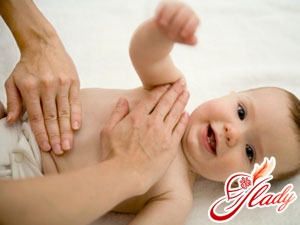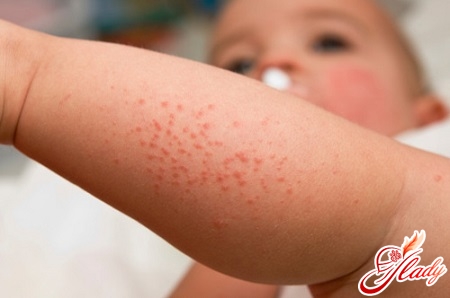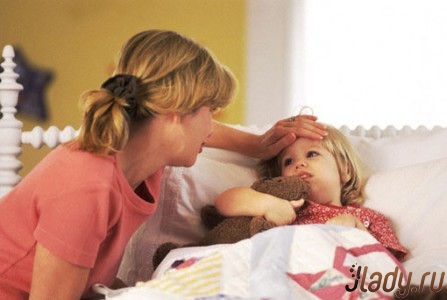 Inguinal, umbilical hernia in children, treatment - theseterms are familiar to very many parents. Quite often parents of small and not very young children hear from a child's surgeon that their baby has a hernia. Of course, parents are frightened and upset when they hear about it. Their imagination draws the most terrible pictures. But is it worth it to panic? Of course, in this disease, as, indeed, in any other, there is nothing good. However, the presence of a hernia in a child is not an excuse for panic and despair. Modern medicine quickly and effectively copes with the most severe forms of a hernia, and very soon your baby will forget that something bothered him. Hernia in children up to a year is eliminated almost without any trace. First you need to know what the hernia is. At its core, the hernia is the bulging through the peritoneal wall under the skin of various internal organs, most often the intestine. The main symptoms of a child's hernia is swelling at the site of protrusion and discomfort when touching this place. In boys, most often inguinal hernia, and in girls - umbilical. However, it happens the other way round. Hernias are of different types, but they all have similar symptoms. The main types of hernias are described in more detail below:
Inguinal, umbilical hernia in children, treatment - theseterms are familiar to very many parents. Quite often parents of small and not very young children hear from a child's surgeon that their baby has a hernia. Of course, parents are frightened and upset when they hear about it. Their imagination draws the most terrible pictures. But is it worth it to panic? Of course, in this disease, as, indeed, in any other, there is nothing good. However, the presence of a hernia in a child is not an excuse for panic and despair. Modern medicine quickly and effectively copes with the most severe forms of a hernia, and very soon your baby will forget that something bothered him. Hernia in children up to a year is eliminated almost without any trace. First you need to know what the hernia is. At its core, the hernia is the bulging through the peritoneal wall under the skin of various internal organs, most often the intestine. The main symptoms of a child's hernia is swelling at the site of protrusion and discomfort when touching this place. In boys, most often inguinal hernia, and in girls - umbilical. However, it happens the other way round. Hernias are of different types, but they all have similar symptoms. The main types of hernias are described in more detail below:
Abdominal hernias
Abdominal all abdominal hernias are called, withwhich extends the internal organs through the abdominal wall. This kind of hernia occurs most often - according to statistical data, every 10 children in Russia suffer from this disease. This article will discuss the most common hernia in children:
- Umbilical hernia
Around the umbilical hernia in children is a hugethe number of the most diverse rumors and conjectures, both truthful and profoundly mistaken. Someone firmly believes that the umbilical hernia can be eliminated by applying coins, conspiracies, and someone - a supporter of radical methods such as surgical intervention. The purpose of this material is to help parents understand the disease and make the only correct decision. Most often, the umbilical hernia occurs in newborn babies, during the first few months. Parents should closely monitor the condition of the tummy of the crumb immediately after the umbilical remnant has fallen off - it is at this time that a bulge appears in the navel region, which is easily inserted inside without surgical intervention, if it was noticed in time. The size of the hernia depends entirely on the size of the baby's umbilical ring. Umbilical ring doctors call the muscle that wraps the navel of the crumbs. After the birth of the baby, the umbilical cord is cut and this ring contracts, because the baby no longer needs an umbilical cord. Here, if an internal organ is involved in the capture of this ring, you can talk about the umbilical hernia. The severity of the course of the disease is 100% dependent on the size of the hernia. If the hernia is small, it can manifest itself only when the crumb is crying or showing a different anxiety - groans, strains the tummy muscles. Experienced doctor - a pediatrician can clearly establish the size of the umbilical ring and its boundaries. To do this, he probes the tummy in the navel, which also allows, in addition to the size of the umbilical ring, to establish the location of the margins of the hernial gates. The area surrounding the protrusion of the hernia is called the margin of the hernia gates. In the event that the size of the umbilical ring of the crumb is sufficiently large, and accordingly, the size of the hernia is also considerable, its manifestations are somewhat different. The swelling is constantly visible, the child is restless. And with the strain of the child, the hernia takes a rather terrible form, greatly protruding and swelling. As a rule, the pediatrician notices the presence of a hernia in the first weeks during the preventive examinations. However, parents should take special care, since if the hernia is small and the child does not show any signs of anxiety during the examination, the doctor may not notice the problem. The parents, who are watching their baby around the clock, are much more likely to notice the problem. Umbilical hernia in children symptoms is quite specific and difficult to confuse with something else. Signs of umbilical hernia in children are easily distinguished even by people who do not have medical education. Timely diagnosis is extremely important, since the umbilical hernia has one unpleasant tendency to increase with time. Therefore, the earlier the disease is detected, the better the treatment will be and the faster it will be able to get rid of the hernia, causing the baby as little as possible inconvenience. Parents, whose babies suffer from umbilical hernia, always worried about what are the causes of the umbilical hernia. Below we are talking about this:
- Hereditary factor
The most common cause of umbilicalHernia is the genetic predisposition of crumbs to the weak muscles of the anterior wall of the peritoneum. In the event that mom or dad had an umbilical hernia in childhood, their babies are more at risk of developing this complication in about 70% of cases. However, sometimes this rule may not work.
- Anatomy of muscle weakness
Often among parents, the mistakenopinion that the cause of the onset of umbilical hernia in children may be improperly trimmed umbilical cord. But in fact, the size of the umbilical ring does not depend on how the umbilical cord was cut and how the umbilical bracket was applied. The onset of umbilical hernia occurs if the child has an anatomical weakness of the muscles near the umbilical ring. As a rule, with umbilical hernia occurs, most often, infringement of intestinal loops. The protrusion of the hernia very easily retracts inwards with the slightest pressure on it. And in the event that the umbilical ring is very large, you can observe with the naked eye the work of the intestine - all of its peristalsis is visible: muscle contraction and food advancement. Of course, many parents, seeing the whole picture, are very frightened. Of course, this sight is not for the faint-hearted people, but believe me - the baby does not cause any anxiety or inconvenience. As already mentioned above, most often the diagnosis of "umbilical hernia" for the baby puts the pediatrician for the first time. However, the baby must also receive a consultation from a pediatric surgeon, who will decide whether further treatment will be conservative or whether surgical intervention will still be required. Also, it is the surgeon who should give parents advice on caring for babies with umbilical hernia. As a rule, very rarely the surgeon decides on the need for an operative intervention in the body of a young child. The peculiarity of the child's organism is that the umbilical hernia in children is to a large extent prone to self-healing. Doctors often observe the cure of umbilical hernias with large sizes, like the umbilical ring, and the very protrusion of the hernia. Many parents, after listening to various terrible stories, are afraid of panic infringement of the umbilical hernia. However, as practice shows and doctors say, infringement of the umbilical hernia is so rare that this threat can be ignored. But, nevertheless, the same pediatricians recognize the fact that babies suffering from umbilical hernias are significantly more restless than their healthy peers. And, in addition, these children are extremely weather-dependent - they react very strongly to all weather changes. Parents should know that the presence of an umbilical hernia does not in any way bring any pain to the baby. However, nevertheless, some discomfort of the baby still feels. It is caused by the fact that the presence of the umbilical hernia often leads to frequent bloating of the tummy in the crumbs. This is what causes the baby's anxiety. 
Treatment of umbilical hernia
We have already spoken about that. That umbilical hernia in young children is very often cured absolutely independently, without any outside interference. However, nevertheless, doctors recommend taking a number of measures to activate the process of curing the umbilical hernia. Proper treatment allows you to fully eliminate even a large umbilical hernia after only 6 months. For children who suffer from umbilical hernia, it will be extremely useful to lay out on the tummy. This measure is relevant both during treatment of an already existing umbilical hernia, and to prevent its occurrence. This simple measure is able to greatly alleviate the condition of the crumbs. Doctors - surgeons recommend parents to put a crumb on the tummy about 15 to 20 minutes before feeding, at least 3 to 4 times a day. Do not spread the crumb on the tummy on the bed or sofa. The most optimal for these purposes is any smooth and, most importantly, a solid surface - for example, a table. Covered with a diaper or changing table. Doing this procedure, do not forget about elementary safety techniques - do not leave a crumb of one for a minute, even in that case. If he is still quite small and does not know how to turn over himself at all. Children's doctors - traumatologists can tell more than a dozen stories about their little patients who. Not knowing how to turn around, somehow found themselves on the floor in an incomprehensible way, it was worthwhile for their mother to turn away for a moment. At a time when the baby lies on the tummy, it will be superfluous to carry out a light massage of the hands, legs and back. It is not necessary to make special efforts, simply gently stroke the crumbs on the handles and legs, lightly pressing them. The duration of the massage should coincide with the duration of laying the baby on his tummy. Typically, a similar procedure is very like almost all children without exception. The next most popular and effective method of treatment, as well as prevention of umbilical hernia in children is a tummy tummy massage. Despite the fact that in a children's polyclinic, a massage performed according to the appointment of a surgeon or pediatrician is carried out only after the baby is two months old, at home parents can begin to massage much earlier. In principle, it can begin to be done immediately after the baby has fully healed umbilical wound. While doing the massage for the smallest of babies, parents should observe the utmost care and accuracy - it is unacceptable to put effort and crush the tummy on your tummy. Such crumbs are quite enough light strokes of the tummy clockwise, starting from the lower left side of the abdomen, towards the right. This stimulates muscles in a certain way, so it is very important to observe this sequence and direction. Stroking should not be done only with your fingers - it is much more effective to use for this purpose the entire inner surface of the palm. Babies older are very useful massage, received from doctors a comic name "I love U". It is carried out as follows - after spreading the crumbs on the tummy, imagine a big U written on his tummy. This is exactly what the intestine looks like. Lubricate the skin of the tummy and your fingers for a better slip with baby cream or oil. After that, with pressure, but very carefully start a tummy massage. First, draw the letter "I" from the left side of the baby's belly from the top down two to three times. This movement helps to move the gases that are present in the intestines of the crumbs, down, beyond the colon. After this, continue to draw the letter "L" in order to propel the gazik along the cross section of the colon. Repeat this action at least three times. After that, draw a letter "U" a few times on the puzzle of crumbs to remove gases from the intestine. After that, start drawing all kinds of circles around the umbilical ring of crumbs. This action must be given enough strength and attention. After all, as has been repeatedly mentioned above, it is because of the weakness and insufficient development of the muscles of the anterior abdominal wall that the formation of an overly wide umbilical ring and, as a consequence, the formation of an umbilical hernia, arise. It is most important to strengthen the rectus muscles of the crumb. Straight called those muscles that are located on either side of the umbilical ring and cover themselves almost entirely the entire abdominal wall of the baby. Strengthen these muscles the masseurs recommend as follows. The thumb and middle finger should be placed at a distance of one centimeter on the right and left side of the baby's umbilical ring. Fingers are very neat, not delivering the baby discomfort, you need to make ten clicks, then just pat the baby's tummy and repeat the pressing. In total, one should make about five such cycles at a time. If the massage is done not for the purpose of prevention, but with the purpose of treating the already existing hernia in the crumb, at the end of the massage, several times pressing the bulging of the umbilical hernia into the tummy of the baby is necessary. As already mentioned above, you need to massage every time after putting the baby on your tummy, but you can spend it a little more often if the baby likes the massage. During the massage, try to observe a few simple and simple rules:
- Be sure to shorten the nails shortly before the massage and remove all ornaments, in order to avoid traumatizing the skin crumbs.
- Make sure that your hands before the massage are clean, dry and warm.
- During the laying of crumbs on the tummy and massage, you must ensure that the temperature in the room was not lower than 22 degrees, otherwise the kid can be capricious and even catch cold.
- All the time, while you are doing the baby massage,closely monitor the reaction of the baby - at the first signs of displeasure, try to change the rhythm of massage movements, intensity of effort. If this measure does not bring any result, and the child will continue to be capricious, the massage should be stopped until the next time.
- In no case should you massage the baby in the event that there are even the slightest signs of any kind of malaise.
Another effective way of conservativetreatment of children's umbilical hernia - this is the imposition of a bandage from an adhesive plaster. However, parents should bear in mind that such treatment is possible only with the permission of the attending physician. It is he who must show how to apply this bandage. However, most often the doctor prefers to impose a bandage on his own. And, by and large, this is an extremely reasonable decision - after all, an incorrectly applied bandage can only worsen a child's condition. For the treatment of umbilical hernia, various specially designed patches are used, which can be bought either in the pharmacy or in the children's store. Before buying such adhesive plasters, please ask your doctor beforehand which type of adhesive plaster is preferable to use in your particular case. The doctor will fix the protrusion of the hernia inside, and the rectus muscles of the abdominal wall will connect directly over the umbilical ring, in the form of two folds, which are fixed with an adhesive plaster. The dressing remains in the crumb for ten days, after which it is removed by a doctor. The doctor assesses the condition of the umbilical hernia - whether the umbilical cord is closed. In the event that it does not close, the dressing is applied for another ten days. As a rule, after a three-fold course of dressing for 10 days. Some surgeons prefer to apply adhesive tapes not around the tummy of the crumbs, but directly to the peri-oophoric region for two to three weeks, without forming a crease. The plaster should be changed every few days, without removing the bandage during bathing. With this method of applying an adhesive plaster, parents can independently, without resorting to the help of a surgeon. In the event that you decide to resort to this method of treatment, you need to buy a hypoallergenic patch. The use of an ordinary plaster often causes a strong irritation of the skin in the crumbs. In the same case, if all the above-described conservative methods of treatment have proved ineffective, and the umbilical hernia is preserved in the child and after one year, the pediatrician and the surgeon decide on the expediency of performing surgical intervention to eliminate umbilical hernia. In the event that this decision applies to your baby, do not be afraid and refuse it - surgery to remove the umbilical hernia is very simple and very well developed. During surgery, surgeons do not affect any internal organs of the crumb, only the muscle layer and skin. If the indication for intervention is umbilical hernia in children, the operation does not pose any threat to the health of the baby. Talking about the methods of treatment of umbilical hernia, we can not fail to mention the so-called folk methods of treatment. Many parents, after learning that their baby has an umbilical hernia, rush to various grandmothers and folk healers, listening to advice from friends, putting on a hernia copper coins and bathing crumbs in various herbal preparations. Some similar methods of treatment have no effect, and some frankly harm the health of the crumbs. A plot of a hernia in children is a waste of time and money. Hernia in an infant should be treated only by doctors. It is much more sensible not to risk the health of the child and put various experiments on it, and immediately after the problem was discovered, seek the help of a qualified doctor. The doctor will adequately assess the child's condition and help without compromising his health - the baby umbilical hernia is easily diagnosed and treatable.
Prevention of disease
As you know, any disease is easierto warn, than to treat. Umbilical hernia is not an exception to the rules. Proper prophylaxis significantly reduces the risk of developing umbilical hernia. The main measures for the prevention of umbilical hernia are described below:
- Prevention of strain on the child
One of the main prevention measures will beavoiding situations where the child is forced to push. Such situations arise as a result of bloating in the baby, which usually occurs due to increased gas production or constipation. In order to avoid constipation, it is most optimal to breastfeed a baby, not a mixture, if the mother's health allows. However, the mother should remember that she also must strictly follow the diet, excluding from her absolutely all products that can somehow provoke increased gas production. Breastfeeding mother, in order not to provoke such a phenomenon, as a navel hernia in children can not be eaten:
- Cow's milk. The exception is dairy products.
- All kinds of nuts.
- All kinds of legumes.
- Sausages, sausages. Smoked meat.
If mom herself is prone to constipation, doctors adviseshe needs to eat a little dried apricots or prunes. However, they should not be abused too much, in order to avoid the appearance of allergic reactions in crumbs. 
Inguinal hernia
Next in frequency of occurrence after umbilical- inguinal hernia. However, in contrast to the umbilical hernia, the groin more often leads to the occurrence of pinching. Any inguinal hernia in a child is nothing other than a congenital pathology resulting from the fact that the child has either a weak abdominal wall or a vaginal process of the peritoneum underdeveloped. Inguinal scrotal hernia in children is one of the types of inguinal hernia. It occurs only in boys, since with this form of the disease the hernia descends into the cavity of the scrotum. The course of the disease and treatment are exactly the same as with the usual inguinal hernia. However, despite the fact that the pathology is congenital, manifestations of inguinal hernia often occur not immediately after the birth of the child, but after several months or even years. This reason is one of the leading reasons for the need for regular visits to a child surgeon in the first few years of a child's life. In no case should parents ignore them. Inguinal hernia in children has the following symptoms:
- The most inguinal hernia manifests itself in the physical load of the child - coughing, crying.
- In the groin area, most often on the right side, a swelling is visualized, the size of which can vary from hazelnut to mandarin.
- When you click on this tumor, it effortlessly goes inside, while the action is accompanied by a gurgling sound.
Inguinal hernia in young children most oftenis oblique, and the right-hand one. Although bilateral hernia, unfortunately, is also very common. As pediatricians noted, the frequency of cases of inguinal hernia in boys is much higher than that of girls. Most often, the presence of a hernia, subject to a regular and timely visit to the surgeon, is possible until the child reaches two to three years of age. Parents should not hope that they will be able to detect the disease in any case. Inguinal hernia in most cases is diagnosed much more difficult than umbilical. And parents notice the presence of a problem only when the hernia acquires sufficiently impressive dimensions. And since the inguinal hernia in children does not perceive the treatment, it is necessary to operate it as early as possible. Removal of inguinal hernia in children passes quickly enough and without complications for health, if the operation was done on time. Separately it is necessary to tell about the contents of inguinal hernias. As a rule, in boys, the intestine is most often contained in the hernia, while in the hernia there is an ovary in the hernia. Although sometimes the girls are infringed by the intestines. The hernia of groin in children causes is very different and it is only the doctor who can precisely fix them. If for some reason the operation can not be performed (usually a child's illness), parents should closely monitor the child's health and know how to identify a hernia from a child when it is infringed. In the event that the protrusion of the hernia to the touch suddenly became firm, it does not fit into the abdominal cavity and causes strong pain in the baby's crumbs; parents should deliver the child as soon as possible to the emergency room of the nearest hospital, or call an ambulance team. A child's inguinal hernia is an indication for urgent hospitalization, since an impaired inguinal hernia in children can become a real threat to life. In addition to the above symptoms, most children start frequent enough and severe vomiting, severe weakness and even loss of consciousness. In no case should parents try to feed and even give the child a drink - otherwise there will be more problems with anesthesia during the forthcoming surgical intervention.
Treatment of inguinal hernia
If the umbilical hernia is still possibletalk about conservative, non-surgical treatment, then the child who has an inguinal hernia is diagnosed with immediate surgical intervention. If inguinal hernia in children, surgery is simply necessary. No other conservative way to get rid of inguinal hernia, except for surgery, simply does not exist. Any delay in surgical intervention can result in quite serious complications for the child's health - as mentioned earlier, inguinal hernia tend to infringe. And the operation of the strangulated hernia is much more complicated, takes more time and requires a long recovery than the planned one. In addition, the consequences can be the most sad, down to infertility in the future. Well, about the fact that infringement of the inguinal hernia represents a serious enough danger for the baby's life, and there is no need to speak. It is much more reasonable to contact a pediatric surgeon in a timely manner and go to the hospital for further surgical intervention. The only case that can be an exception is the inguinal hernia in infants. But also the operation should be done immediately after they are six months old. Parents should not be afraid of the upcoming operation and panic. The inguinal hernia is very common, and all surgeons have worked out the technique of carrying out this type of operation without exception to the slightest subtleties. And the anesthesiologist will necessarily pick up the most optimal and sparing kind of anesthesia, based on the individual needs of your crumbs and the characteristics of his body.
Diaphragmatic hernia
There is also a diaphragmatic hernia in children. This type of hernia is one of the hardest congenital malformations, often incompatible with life. However, recently, with the development of modern medicine, these kids are more and more often not only survive, but they also have the opportunity to lead a full life. The cause of the diaphragmatic hernia is the end of the not intergrown pleuroperitoneal membrane. As a result, the internal organs of the abdominal cavity (spleen, stomach, thick and small intestine) move inside the chest. As a rule, an ordinary complication in children with diaphragmatic hernia is lung hypoplasia, as well as pulmonary hypertension. In the same case, if all of these problems are associated with a deficit in heart mass, the predictions significantly and sharply worsen. In any case, with whatever form of the disease the child does not encounter parents, they need to apply for qualified medical care as soon as possible to the children's medical institution.









